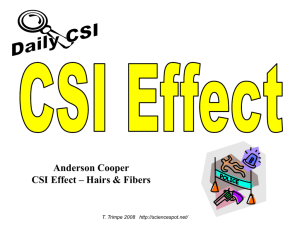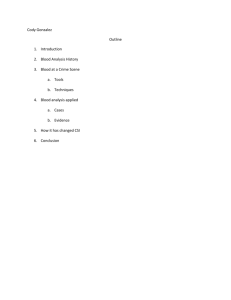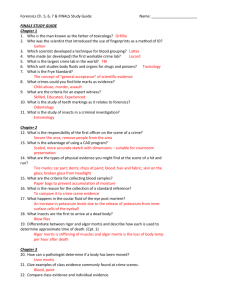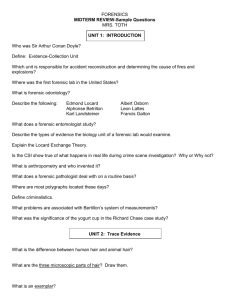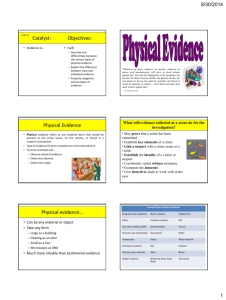Chapter 1: Introduction to Forensic Science
advertisement
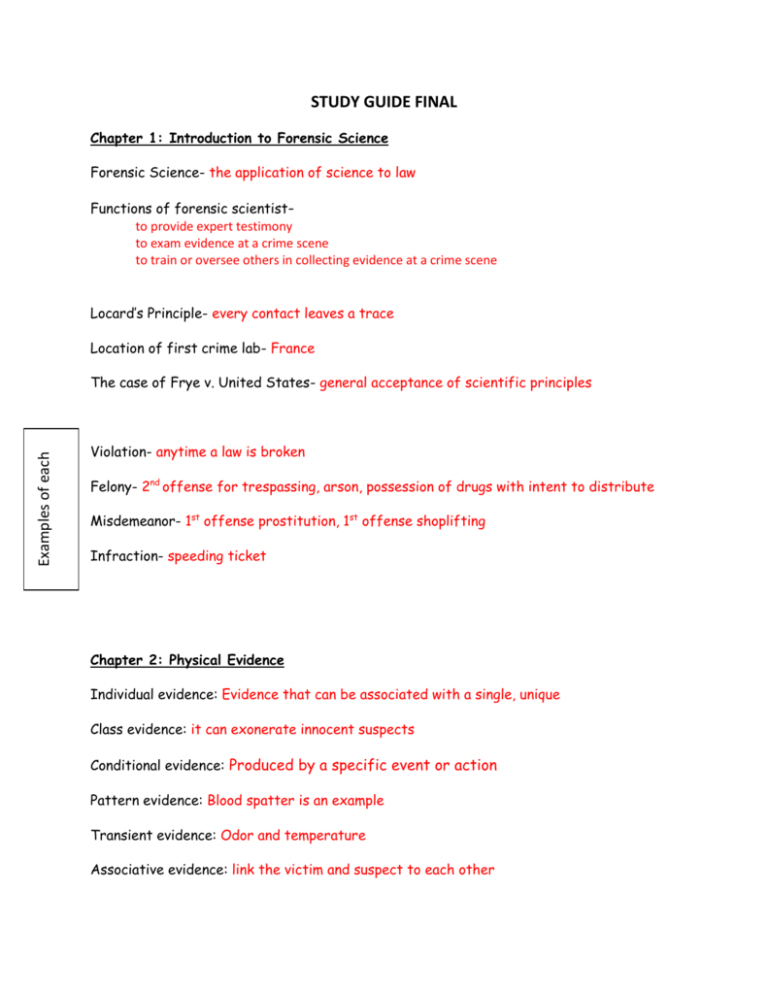
STUDY GUIDE FINAL Chapter 1: Introduction to Forensic Science Forensic Science- the application of science to law Functions of forensic scientistto provide expert testimony to exam evidence at a crime scene to train or oversee others in collecting evidence at a crime scene Locard’s Principle- every contact leaves a trace Location of first crime lab- France Examples of each The case of Frye v. United States- general acceptance of scientific principles Violation- anytime a law is broken Felony- 2nd offense for trespassing, arson, possession of drugs with intent to distribute Misdemeanor- 1st offense prostitution, 1st offense shoplifting Infraction- speeding ticket Chapter 2: Physical Evidence Individual evidence: Evidence that can be associated with a single, unique Class evidence: it can exonerate innocent suspects Conditional evidence: Produced by a specific event or action Pattern evidence: Blood spatter is an example Transient evidence: Odor and temperature Associative evidence: link the victim and suspect to each other Chapter 3: The Crime Scene Steps in approaching crime scene1. check the body if there is one, and get medical attention Personal Safety and the well-being of victims Preserve and Isolate the crime scene Record the crime scene Primary responsibility of initial responder- interview with the witnesses, control the scene Packaging of blood evidence- dried before packaging to prevent mold and mildew How many hours can it stay in plastic container before it is contaminated? 2 Chain of custody- Every person who handled the evidence must be accounted for on the written record must be followed or the evidence may not be admitted into court Spiral search- May move inward or outward; best used where there are no physical barriers Strip search- Best in large, outdoor scenes Grid search- Basically a double-line search; effective, but time-consuming Zone search- search pattern breaks the area down into smaller sectors Coroner vs. medical doctor: How many states is the coroner ALSO a medical doctor? four What states? Louisiana Cases: Mark Winger, Jeffrey MacDonlad Winger- convicted based on expert testimony from a visual information specialist. MacDonald- the chain of custody was broken resulting in a delay in the trial Chapter 4: Fingerprints Friction ridges- located on epidermis part of skin Be able to identify the following print patterns: Plain Arch Tented Arch Double Loop Central Pocket Whorl Plain Whorl Accidental Ulnar Loop Radial Loop Cases you should study: Mark Winger Case Winger- convicted based on expert testimony from a visual information specialist. Jennings- The first homicide case in North America involving fingerprint evidence occurred at his murder trial Hamm Kidnapping Case- The first time silver nitrate was used successfully to visualize latent prints Methods to visualize prints: (what do they react to?) iodine fuming- particularly useful for visualizing prints on porous surfaces, reacts with oils and fatty deposits to produce a brown residue that can be used to visualize fingerprints ninhydrin- particularly useful for visualizing prints on porous surfaces powders- particularly useful for visualizing prints on porous surfaces cyanoacrylate- “superglue fuming” Chapter 5: Hair Trace Evidence- Physical evidence found in small but measurable amounts False Positive Test- A test result that comes out positive when it should not Cuticle- Tough, clear outside covering of the hair shaft (examples of each) Coronal:mouse spinous: cat imbricate: human Cortex- Middle layer of the hair shaft that provides strength Anagen Phase- Period of hair growth in the hair cycle averaging 3-5 years Medulla- The spongy interior core of hair that gives flexibility Telogen Phase- Final phase in hair growth resulting in hair loss Catagen Phase- Intermediate period of hair growth lasting three weeks How much will hair grow in one month? 1 cm Chapter 6: Fibers Collection of fibers - Brushing: used for collection of fiber evidence - Vacuuming: used for collection of fiber evidence - Adhesive tape: used for collection of fiber evidence Fabrics: made from twisted filaments Cases: Wayne Williams - Fibers found in Chevrolet station wagon - Convicted of two murders - 28 pieces of microscopic evidence were found on the victims - 19 fibers were linked to more than one victim Chapters 7 and 8: Drugs and Toxicology acutely toxic- occur almost immediately upon exposure Drug- A natural or synthetic substance designed to affect the suspect psychologically pr physiologically Toxin- A life threatening material Toxicology- The study of adverse effects of chemicals or physical agents on living organisms Control- A sample of known composition w/out any material to be compared LD50- The dose that kills 50% of the test population Schedules (examples for each) I- High potential for abuse; heroin, LSD, ecstasy (MDMA), marijuana II- Currently accepted medical use with severe restrictions; cocaine, morphine, amphetamines, Ritalin, PCP, opium III- Lower potential for abuse ; Barbiturates, anabolic steroids, and ketamine IV- Abuse may lead to limited psychological or physical; other stimulants & depressants, valium, Darvon, librium, phenobarbital Include examples of each, what effect it has on the body V- Lower potential for abuse relative to drugs in VI; codeine found in cough medicine Hallucinogen- hallucinogen Stimulant- speed up CNS; Ritalin, amphetamines Narcotic- Induce a state of sluggishness, codeine, heroin. morphine, oxycontin Depressant- Slow down the CNS; alcohol, inhalants Tests: which drugs do these reagents test for? Duquenois-Levine- marijuana Cobalt thiocynate- amphetamines Van Urk- LSD Dillie-Koppanyl- barbiturates Marquis- heroin Cases: Tylenol murders- killed 7 people Chapter 10: Serology Antiserum- blood serum containing specific antigens Antigen- protein found on the surface of a red blood cell that determines blood type. Platelets- Responsible for blood clotting Hemoglobin-contsained in the erythrocytes Terminal Velocity- The greatest speed to which a free falling drop of blood can accelerate in the air Bloodstain Transfer- When a bloody object comes into contact with a surface and leaves a patterned blood image on the surface. Cast-Off- Blood that is thrown from an object in motion Angle of Impact- Angle at which blood strikes a target surface Swipe- Wet blood is transferred to a surface which didn’t have blood Void- An absence of stains in an otherwise continuous bloodstain pattern Wipe- A non-blood bearing object moves through a wet bloodstain, altering the appearance of the original stain Area of Convergence- The point of origin; the spot the blow occurred Backspatter- Blood that is directed back toward the source of energy Point of Convergence- The intersection of two bloodstain paths, where the stains come from opposite sides of the impact area Contact Stain- Bloodstains caused by contact between a wet blood bearing surface and a second surface which may or may not have blood on it Satellite Spatter- Small droplets of blood that are distributed around a drop or pool of blood as a result of the blood impacting the target area Know what the following patterns looks like: Low Velocity Passive Cast-Off High Velocity Arterial Spurt Wipe Medium Velocity Transfer Swipe Cases: Sam Sheppard- proven not guilty because he was right-handed, Tests: secretor test- Acid Phosphatase Color Test, detects by placing sodium alpha naphthylphosphate and Fast Blue B solution are on it. luminal test- cannot distinguish between human and animal blood, uses light Kastle-Meyer test- presumptive test, answers “is it blood” precipitin test- To test whether a suspected blood stain is human or animal, an investigator could use the ABO system O: antigens: AB antigens antibodies: none AB: antigens: AB A: antigens: B: antigen A B antibodies: AB antibodies: antibodies: B A What occurs when blood type A is mixed with blood type B? agglutination Handwriting and Document Analysis Diacritics: crossing of t’s and dotting of i’s Traits considered in handwriting analysis: Line quality, which indicates the amount of pressure used by the author, Letter form, which includes curves, connections, slants, size and angles How many examples are needed for handwriting analysis? 3 Suggested steps to minimize a conscious writing effort on the part of a suspect? Have suspect write a verbal statement that contains words from the original writing Cases: Lindberg kidnapping- Handwriting analysis aided in the investigation of which famous crime
